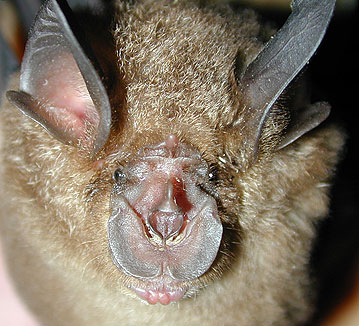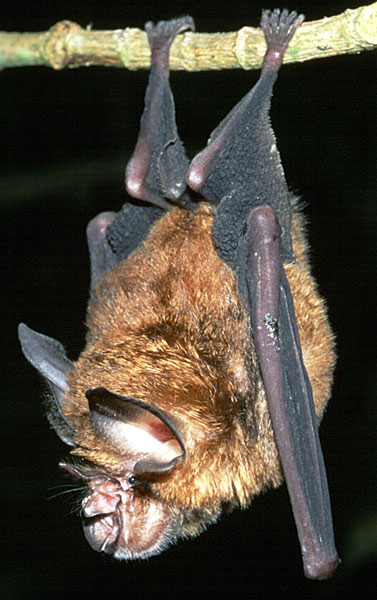Rhinolophus stheno
Lesser Brown Horseshoe Bat
Morphological description Life history Distribution Habitat Roost sites and roosting patterns Emergence and flight pattern Foraging behaviour Echolocation calls Status and protection


Right hand photo - Tigga Kingston
Morphological Description
·Medium-sized horseshoe bat. Horseshoe covers most of muzzle, and a clear supplementary noseleaf is present. Lower lip has 3 grooves (Csorba et al. 2003).
·Dorsal pelage light yellow-brown at base, reddish cinnamon-brown above. Underparts lighter (Csorba et al. 2003).
· Forearm length 41-47.5 mm (Csorba et al. 2003).Bats in China were 42.9 ± 0.92 mm, mass 10.3 ± 1.40 g (n = 6).
Life history
· Little known
Distribution
Thailand, Lao PDR, Vietnam, Peninsula Malaysia, Sumatra, Java (Csorba et al. 2003). Three males and 3 females captured in Yunnan in 2002 were the first records for China.
Habitat
· Little known. In Malaysia, their main habitat is rainforests (Kingston et al. 2006).
Roost sites and roosting behaviour
· Generally roosts in caves.
· This species often shares cave roosts with other bat species.
Emergence and flight pattern
· Most rhinolophid bats have wing shapes that make them adept at foraging in cluttered environments.
Foraging behaviour
· Not known.
Echolocation calls
· The echolocation calls had a frequency of most energy about 87.2 kHz in Yunnan, while Robinson (1996) reported 85-90 kHz (FA 46 mm), and Kingston (2000) documented 86.1 kHz (FA 48.8 mm), both in Malaysia.
Status and protection
· There is no estimation of population size for China.
· Because the species has only been recorded at one site, it is probably very localised.
· Caves and rainforests should be protected as their habitats.
· IUCN global status Least Concern, populations stable.